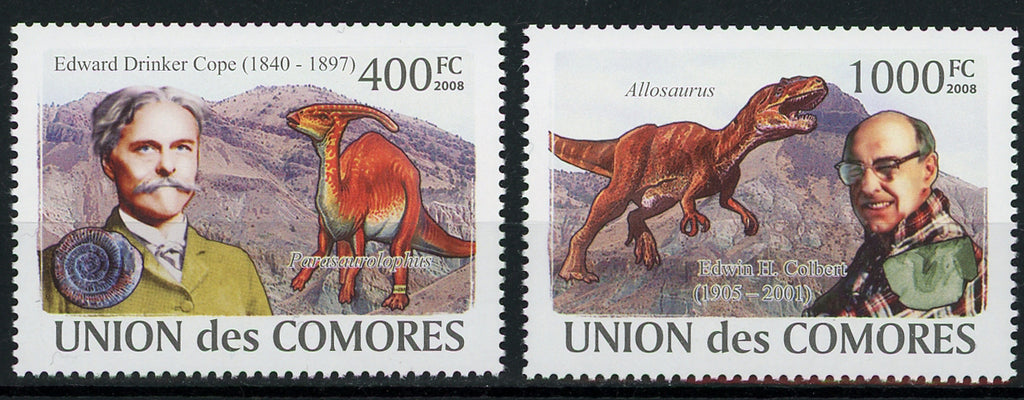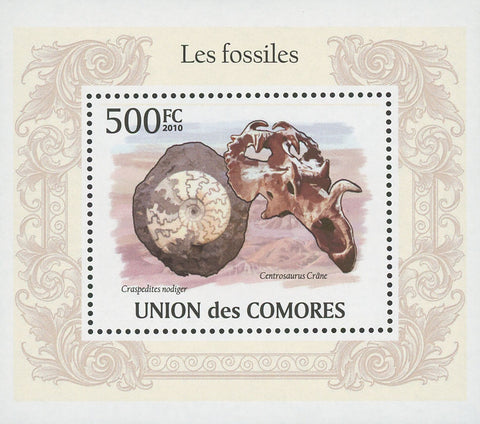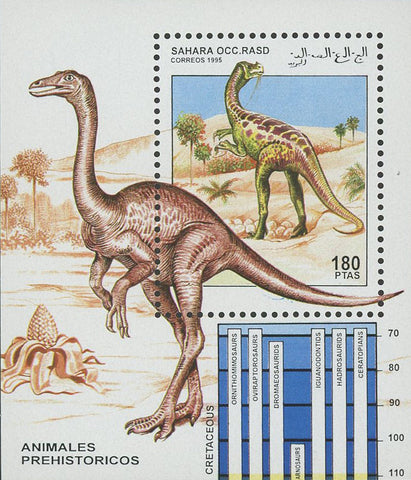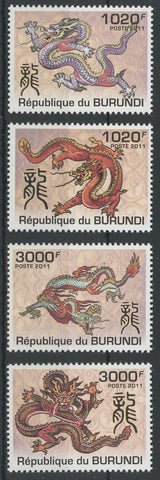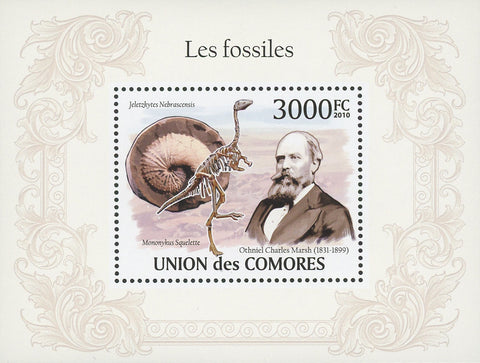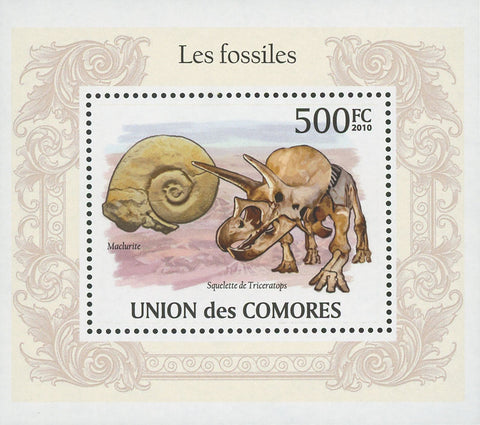Paleontologist Dinosaur Serie Set of 2 Stamps Mint NH
Add to wishlist
Dinosaurs are a varied group of animals from taxonomic, morphological and ecological standpoints. Birds, at over 10,000 living species, are the most diverse group of vertebrates besides perciform fish. Using fossil evidence, paleontologists have identified over 500 distinct genera and more than 1,000 different species of non-avian dinosaurs. Dinosaurs are represented on every continent by both extant species (birds) and fossil remains. Through the first half of the 20th century, before birds were recognized to be dinosaurs, most of the scientific community believed dinosaurs to have been sluggish and cold-blooded. Most research conducted since the 1970s, however, has indicated that all dinosaurs were active animals with elevated metabolisms and numerous adaptations for social interaction. Some were herbivorous, others carnivorous. Evidence suggests that egg-laying and nest-building are additional traits shared by all dinosaurs, avian and non-avian alike.
While dinosaurs were ancestrally bipedal, many extinct groups included quadrupedal species, and some were able to shift between these stances. Elaborate display structures such as horns or crests are common to all dinosaur groups, and some extinct groups developed skeletal modifications such as bony armor and spines. While the dinosaurs' modern-day surviving avian lineage (birds) are generally small due to the constraints of flight, many prehistoric dinosaurs (non-avian and avian) were large-bodied—the largest sauropod dinosaurs are estimated to have reached lengths of 39.7 meters (130 feet) and heights of 18 meters (59 feet) and were the largest land animals of all time. Still, the idea that non-avian dinosaurs were uniformly gigantic is a misconception based in part on preservation bias, as large, sturdy bones are more likely to last until they are fossilized. Many dinosaurs were quite small: Xixianykus, for example, was only about 50 cm (20 in) long.
Paleontologist Dinosaur Serie Set of 2 Stamps Mint NH
$14.92
- Product Sku:
- Categories Comoros, Pre-historic Animals, Science
Comoros Paleontologists Dinosaurs Souvenir Sheet Mint NH
Dinosaurs are a diverse group of reptiles[note 1] of the clade Dinosauria. They first appeared during the Triassic period, between 243 and 233.23 million years ago,[1][2] although the exact origin and timing of the evolution of dinosaurs is the subject of active research.[3] They became the dominant terrestrial vertebrates after the Triassic–Jurassic extinction event 201 million years ago; their dominance continued through the Jurassic and Cretaceous periods. Reverse genetic engineering[4] and the fossil record both demonstrate that birds are modern feathered dinosaurs,[5] having evolved from earlier theropods during the late Jurassic Period.[6] As such, birds were the only dinosaur lineage to survive the Cretaceous–Paleogene extinction event 66 million years ago.[7] Dinosaurs can therefore be divided into avian dinosaurs, or birds; and non-avian dinosaurs, which are all dinosaurs other than birds. This article deals primarily with non-avian dinosaurs.Dinosaurs are a varied group of animals from taxonomic, morphological and ecological standpoints. Birds, at over 10,000 living species, are the most diverse group of vertebrates besides perciform fish. Using fossil evidence, paleontologists have identified over 500 distinct genera and more than 1,000 different species of non-avian dinosaurs. Dinosaurs are represented on every continent by both extant species (birds) and fossil remains. Through the first half of the 20th century, before birds were recognized to be dinosaurs, most of the scientific community believed dinosaurs to have been sluggish and cold-blooded. Most research conducted since the 1970s, however, has indicated that all dinosaurs were active animals with elevated metabolisms and numerous adaptations for social interaction. Some were herbivorous, others carnivorous. Evidence suggests that egg-laying and nest-building are additional traits shared by all dinosaurs, avian and non-avian alike.
While dinosaurs were ancestrally bipedal, many extinct groups included quadrupedal species, and some were able to shift between these stances. Elaborate display structures such as horns or crests are common to all dinosaur groups, and some extinct groups developed skeletal modifications such as bony armor and spines. While the dinosaurs' modern-day surviving avian lineage (birds) are generally small due to the constraints of flight, many prehistoric dinosaurs (non-avian and avian) were large-bodied—the largest sauropod dinosaurs are estimated to have reached lengths of 39.7 meters (130 feet) and heights of 18 meters (59 feet) and were the largest land animals of all time. Still, the idea that non-avian dinosaurs were uniformly gigantic is a misconception based in part on preservation bias, as large, sturdy bones are more likely to last until they are fossilized. Many dinosaurs were quite small: Xixianykus, for example, was only about 50 cm (20 in) long.
Fast & Free Shipping within U.S.A.
We Care for your order, Pack it carefully and ship it within 24 hours.
Satisfaction Guaranteed!
Please explore our store for more stamps, souvenir sheets, post-office collectibles and philately books and pre-philatelic items:
montecinos.philately

Related Products
{"id":1739822923833,"title":"Fossils Centaurus Crane Mini Sov. Sheet MNH","handle":"comoros-fossils-centaurus-crane-mini-sov-sheet-mnh","description":"\u003cp\u003eFossils Centaurus Crane Mini Sov. Sheet MNH\u003c\/p\u003e\n\u003cp\u003eA fossil (from Classical Latin fossilis; literally, \"obtained by digging\") is any preserved remains, impression, or trace of any once-living thing from a past geological age. Examples include bones, shells, exoskeletons, stone imprints of animals or microbes, objects preserved in amber, hair, petrified wood, oil, coal, and DNA remnants. The totality of fossils is known as the fossil record.\u003cbr\u003e\u003cbr\u003ePaleontology is the study of fossils: their age, method of formation, and evolutionary significance. Specimens are usually considered to be fossils if they are over 10,000 years old. The oldest fossils are from around 3.48 billion years old to 4.1 billion years old. The observation in the 19th century that certain fossils were associated with certain rock strata led to the recognition of a geological timescale and the relative ages of different fossils. The development of radiometric dating techniques in the early 20th century allowed scientists to quantitatively measure the absolute ages of rocks and the fossils they host.\u003cbr\u003e\u003cbr\u003eThere are many processes that lead to fossilization, including permineralization, casts and molds, authigenic mineralization, replacement and recrystallization, adpression, carbonization, and bioimmuration.\u003c\/p\u003e\n\u003cp\u003e\u003cspan\u003eFast \u0026amp; Free Shipping within U.S.A. \u003c\/span\u003e\u003cbr\u003e\u003cbr\u003e\u003cspan\u003eWe Care for your order, Pack it carefully and ship it within 48 hours. \u003c\/span\u003e\u003cbr\u003e\u003cbr\u003e\u003cspan\u003eSatisfaction Guaranteed! \u003c\/span\u003e\u003cbr\u003e\u003cbr\u003e\u003cspan\u003ePlease explore our store for more stamps, souvenir sheets, post-office collectibles and philately books and pre-philatelic items: \u003c\/span\u003e\u003cbr\u003e\u003cspan\u003emontecinos.philately\u003c\/span\u003e\u003c\/p\u003e","published_at":"2018-09-29T23:47:02-04:00","created_at":"2018-10-09T21:42:30-04:00","vendor":"Montecinos Philately","type":"Souvenir Sheet","tags":["Category_Souvenir Sheet","Comoros","Condition_MNH"],"price":1741,"price_min":1741,"price_max":1741,"available":true,"price_varies":false,"compare_at_price":null,"compare_at_price_min":0,"compare_at_price_max":0,"compare_at_price_varies":false,"variants":[{"id":17184521289785,"title":"Default Title","option1":"Default Title","option2":null,"option3":null,"sku":"A13-417","requires_shipping":true,"taxable":true,"featured_image":null,"available":true,"name":"Fossils Centaurus Crane Mini Sov. Sheet MNH","public_title":null,"options":["Default Title"],"price":1741,"weight":113,"compare_at_price":null,"inventory_management":"shopify","barcode":null,"requires_selling_plan":false,"selling_plan_allocations":[]}],"images":["\/\/meditative-philately.com\/cdn\/shop\/products\/A13-417.jpg?v=1539135761"],"featured_image":"\/\/meditative-philately.com\/cdn\/shop\/products\/A13-417.jpg?v=1539135761","options":["Title"],"media":[{"alt":null,"id":2342790430777,"position":1,"preview_image":{"aspect_ratio":1.132,"height":828,"width":937,"src":"\/\/meditative-philately.com\/cdn\/shop\/products\/A13-417.jpg?v=1539135761"},"aspect_ratio":1.132,"height":828,"media_type":"image","src":"\/\/meditative-philately.com\/cdn\/shop\/products\/A13-417.jpg?v=1539135761","width":937}],"requires_selling_plan":false,"selling_plan_groups":[],"content":"\u003cp\u003eFossils Centaurus Crane Mini Sov. Sheet MNH\u003c\/p\u003e\n\u003cp\u003eA fossil (from Classical Latin fossilis; literally, \"obtained by digging\") is any preserved remains, impression, or trace of any once-living thing from a past geological age. Examples include bones, shells, exoskeletons, stone imprints of animals or microbes, objects preserved in amber, hair, petrified wood, oil, coal, and DNA remnants. The totality of fossils is known as the fossil record.\u003cbr\u003e\u003cbr\u003ePaleontology is the study of fossils: their age, method of formation, and evolutionary significance. Specimens are usually considered to be fossils if they are over 10,000 years old. The oldest fossils are from around 3.48 billion years old to 4.1 billion years old. The observation in the 19th century that certain fossils were associated with certain rock strata led to the recognition of a geological timescale and the relative ages of different fossils. The development of radiometric dating techniques in the early 20th century allowed scientists to quantitatively measure the absolute ages of rocks and the fossils they host.\u003cbr\u003e\u003cbr\u003eThere are many processes that lead to fossilization, including permineralization, casts and molds, authigenic mineralization, replacement and recrystallization, adpression, carbonization, and bioimmuration.\u003c\/p\u003e\n\u003cp\u003e\u003cspan\u003eFast \u0026amp; Free Shipping within U.S.A. \u003c\/span\u003e\u003cbr\u003e\u003cbr\u003e\u003cspan\u003eWe Care for your order, Pack it carefully and ship it within 48 hours. \u003c\/span\u003e\u003cbr\u003e\u003cbr\u003e\u003cspan\u003eSatisfaction Guaranteed! \u003c\/span\u003e\u003cbr\u003e\u003cbr\u003e\u003cspan\u003ePlease explore our store for more stamps, souvenir sheets, post-office collectibles and philately books and pre-philatelic items: \u003c\/span\u003e\u003cbr\u003e\u003cspan\u003emontecinos.philately\u003c\/span\u003e\u003c\/p\u003e"}
You may also like:
Fossils Centaurus Crane Mini Sov. Sheet MNH
Fossils Centaurus Crane Mini Sov. Sheet MNH A fossil (from Classical Latin fossilis; literally, "obtained...
$17.41
{"id":4755871301702,"title":"Western Sahara Dinosaur Stamp Prehistoric Animal Morocco Occ. R.A.S.D S\/S MNH","handle":"western-sahara-dinosaur-stamp-prehistoric-animal-morocco-occ-r-a-s-d-souvenir-sheet-mnh","description":"\u003caudio class=\"audio-for-speech\"\u003e\u003c\/audio\u003e\n\u003cdiv class=\"translate-tooltip-mtz hidden\"\u003e\n\u003cdiv class=\"header\"\u003e\n\u003cdiv class=\"header-controls\"\u003e\n\u003cspan class=\"sound-translate\"\u003e\u003c\/span\u003e \u003cspan class=\"settings\"\u003e\u003c\/span\u003e\n\u003c\/div\u003e\n\u003cdiv class=\"translate-icons\"\u003e\u003c\/div\u003e\n\u003c\/div\u003e\n\u003c\/div\u003e\n\u003cdiv class=\"translate-tooltip-mtz hidden\"\u003e\n\u003cdiv class=\"header\"\u003e\u003c\/div\u003e\n\u003cdiv class=\"translated-text\"\u003e\n\u003cdiv class=\"words\"\u003e\u003c\/div\u003e\n\u003cdiv class=\"sentences\"\u003e\u003c\/div\u003e\n\u003c\/div\u003e\n\u003c\/div\u003e\n\u003cspan style=\"top: 707px; left: 262.9140625px;\" class=\"translate-button-mtz\"\u003e\u003c\/span\u003e\n\u003cdiv id=\"inkfrog_crosspromo_top\"\u003e\u003c\/div\u003e\n\u003cdiv id=\"inkfrog_crosspromo_top\"\u003e\u003c\/div\u003e\n\u003cp style=\"text-align: center;\"\u003e\u003cstrong\u003eWestern Sahara Dinosaur Stamp Prehistoric Animal Morocco Occ. R.A.S.D Souvenir Sheet MNH\u003c\/strong\u003e\u003c\/p\u003e\n\u003cp\u003eDinosaurs are a diverse group of reptiles of the clade Dinosauria. They first appeared during the Triassic period, between 243 and 233.23 million years ago, although the exact origin and timing of the evolution of dinosaurs is the subject of active research. They became the dominant terrestrial vertebrates after the Triassic–Jurassic extinction event 201.3 million years ago; their dominance continued throughout the Jurassic and Cretaceous periods. The fossil record shows that birds are modern feathered dinosaurs, having evolved from earlier theropods during the Late Jurassic epoch, and are the only dinosaur lineage to survive the Cretaceous–Paleogene extinction event approximately 66 million years ago. Dinosaurs can therefore be divided into avian dinosaurs, or birds; and non-avian dinosaurs, which are all dinosaurs other than birds.\u003c\/p\u003e\n\u003cp style=\"text-align: center;\"\u003e\u003cstrong\u003eFast \u0026amp; Free Shipping within U.S.A. \u003c\/strong\u003e\u003cbr\u003e\u003cbr\u003e\u003cstrong\u003eWe Care for your order, Pack it carefully and ship it within 48 hours. \u003c\/strong\u003e\u003cbr\u003e\u003cbr\u003e\u003cstrong\u003eSatisfaction Guaranteed! \u003c\/strong\u003e\u003cbr\u003e\u003cbr\u003e\u003cstrong\u003ePlease explore our store for more stamps, souvenir sheets, post-office collectibles and philately books and pre-philatelic items: \u003c\/strong\u003e\u003cbr\u003e\u003cstrong\u003emontecinos.philately\u003c\/strong\u003e\u003c\/p\u003e\n\u003cdiv id=\"inkfrog_crosspromo_bottom\"\u003e\u003c\/div\u003e\n\u003cimg src=\"https:\/\/hit.inkfrog.com\/t\/hit.gif\"\u003e","published_at":"2020-11-10T19:29:08-05:00","created_at":"2020-11-10T19:29:08-05:00","vendor":"Montecinos Philately","type":"Souvenir Sheet","tags":["Category_Souvenir Sheet","Condition_MNH"],"price":1568,"price_min":1568,"price_max":1568,"available":true,"price_varies":false,"compare_at_price":null,"compare_at_price_min":0,"compare_at_price_max":0,"compare_at_price_varies":false,"variants":[{"id":32201423061062,"title":"Default Title","option1":"Default Title","option2":null,"option3":null,"sku":"A36-127","requires_shipping":true,"taxable":true,"featured_image":null,"available":true,"name":"Western Sahara Dinosaur Stamp Prehistoric Animal Morocco Occ. R.A.S.D S\/S MNH","public_title":null,"options":["Default Title"],"price":1568,"weight":113,"compare_at_price":null,"inventory_management":"shopify","barcode":null,"requires_selling_plan":false,"selling_plan_allocations":[]}],"images":["\/\/meditative-philately.com\/cdn\/shop\/products\/A36-127.jpg?v=1605054625"],"featured_image":"\/\/meditative-philately.com\/cdn\/shop\/products\/A36-127.jpg?v=1605054625","options":["Title"],"media":[{"alt":null,"id":6762967498822,"position":1,"preview_image":{"aspect_ratio":0.857,"height":812,"width":696,"src":"\/\/meditative-philately.com\/cdn\/shop\/products\/A36-127.jpg?v=1605054625"},"aspect_ratio":0.857,"height":812,"media_type":"image","src":"\/\/meditative-philately.com\/cdn\/shop\/products\/A36-127.jpg?v=1605054625","width":696}],"requires_selling_plan":false,"selling_plan_groups":[],"content":"\u003caudio class=\"audio-for-speech\"\u003e\u003c\/audio\u003e\n\u003cdiv class=\"translate-tooltip-mtz hidden\"\u003e\n\u003cdiv class=\"header\"\u003e\n\u003cdiv class=\"header-controls\"\u003e\n\u003cspan class=\"sound-translate\"\u003e\u003c\/span\u003e \u003cspan class=\"settings\"\u003e\u003c\/span\u003e\n\u003c\/div\u003e\n\u003cdiv class=\"translate-icons\"\u003e\u003c\/div\u003e\n\u003c\/div\u003e\n\u003c\/div\u003e\n\u003cdiv class=\"translate-tooltip-mtz hidden\"\u003e\n\u003cdiv class=\"header\"\u003e\u003c\/div\u003e\n\u003cdiv class=\"translated-text\"\u003e\n\u003cdiv class=\"words\"\u003e\u003c\/div\u003e\n\u003cdiv class=\"sentences\"\u003e\u003c\/div\u003e\n\u003c\/div\u003e\n\u003c\/div\u003e\n\u003cspan style=\"top: 707px; left: 262.9140625px;\" class=\"translate-button-mtz\"\u003e\u003c\/span\u003e\n\u003cdiv id=\"inkfrog_crosspromo_top\"\u003e\u003c\/div\u003e\n\u003cdiv id=\"inkfrog_crosspromo_top\"\u003e\u003c\/div\u003e\n\u003cp style=\"text-align: center;\"\u003e\u003cstrong\u003eWestern Sahara Dinosaur Stamp Prehistoric Animal Morocco Occ. R.A.S.D Souvenir Sheet MNH\u003c\/strong\u003e\u003c\/p\u003e\n\u003cp\u003eDinosaurs are a diverse group of reptiles of the clade Dinosauria. They first appeared during the Triassic period, between 243 and 233.23 million years ago, although the exact origin and timing of the evolution of dinosaurs is the subject of active research. They became the dominant terrestrial vertebrates after the Triassic–Jurassic extinction event 201.3 million years ago; their dominance continued throughout the Jurassic and Cretaceous periods. The fossil record shows that birds are modern feathered dinosaurs, having evolved from earlier theropods during the Late Jurassic epoch, and are the only dinosaur lineage to survive the Cretaceous–Paleogene extinction event approximately 66 million years ago. Dinosaurs can therefore be divided into avian dinosaurs, or birds; and non-avian dinosaurs, which are all dinosaurs other than birds.\u003c\/p\u003e\n\u003cp style=\"text-align: center;\"\u003e\u003cstrong\u003eFast \u0026amp; Free Shipping within U.S.A. \u003c\/strong\u003e\u003cbr\u003e\u003cbr\u003e\u003cstrong\u003eWe Care for your order, Pack it carefully and ship it within 48 hours. \u003c\/strong\u003e\u003cbr\u003e\u003cbr\u003e\u003cstrong\u003eSatisfaction Guaranteed! \u003c\/strong\u003e\u003cbr\u003e\u003cbr\u003e\u003cstrong\u003ePlease explore our store for more stamps, souvenir sheets, post-office collectibles and philately books and pre-philatelic items: \u003c\/strong\u003e\u003cbr\u003e\u003cstrong\u003emontecinos.philately\u003c\/strong\u003e\u003c\/p\u003e\n\u003cdiv id=\"inkfrog_crosspromo_bottom\"\u003e\u003c\/div\u003e\n\u003cimg src=\"https:\/\/hit.inkfrog.com\/t\/hit.gif\"\u003e"}
You may also like:
Western Sahara Dinosaur Stamp Prehistoric Animal Morocco Occ. R.A.S.D S/S MNH
Western Sahara Dinosaur Stamp Prehistoric Animal Morocco Occ. R.A.S.D Souvenir Sheet MNH Dinosaurs are a...
$15.68
{"id":1838833401913,"title":"Chinese Dragon China Culture Serie Set of 4 Stamps Mint NH","handle":"burundi-chinese-dragon-china-culture-serie-set-of-4-stamps-mint-nh","description":"\u003cdiv id=\"inkfrog_crosspromo_top\"\u003e\u003c\/div\u003e\n\u003cdiv id=\"inkfrog_crosspromo_top\"\u003e\u003c\/div\u003e\n\u003cp\u003eBurundi Chinese Dragon China Culture Serie Set of 4 Stamps Mint NH\u003c\/p\u003e\n\u003cp\u003eChinese dragons, also known as East Asian dragons, are legendary creatures in Chinese mythology, Chinese folklore, and East Asian culture at large. Chinese dragons have many animal-like forms such as turtles and fish, but are most commonly depicted as snake-like with four legs. They traditionally symbolize potent and auspicious powers, particularly control over water, rainfall, typhoons, and floods. The dragon is also a symbol of power, strength, and good luck for people who are worthy of it in East Asian culture. During the days of Imperial China, the Emperor of China usually used the dragon as a symbol of his imperial power and strength.\u003cbr\u003e\u003cbr\u003ePortrait of the Yongle Emperor wearing a dragon robe\u003cbr\u003eIn Chinese culture, excellent and outstanding people are compared to a dragon, while incapable people with no achievements are compared to other, disesteemed creatures, such as a worm. A number of Chinese proverbs and idioms feature references to a dragon, such as \"Hoping one's son will become a dragon\" (simplified Chinese: 望子成龙; traditional Chinese: 朢子成龍; pinyin: wàng zǐ chéng lóng).\u003c\/p\u003e\n\u003cp\u003e\u003cspan\u003eFast \u0026amp; Free Shipping within U.S.A. \u003c\/span\u003e\u003cbr\u003e\u003cbr\u003e\u003cspan\u003eWe Care for your order, Pack it carefully and ship it within 48 hours. \u003c\/span\u003e\u003cbr\u003e\u003cbr\u003e\u003cspan\u003eSatisfaction Guaranteed! \u003c\/span\u003e\u003cbr\u003e\u003cbr\u003e\u003cspan\u003ePlease explore our store for more stamps, souvenir sheets, post-office collectibles and philately books and pre-philatelic items: \u003c\/span\u003e\u003cbr\u003e\u003cspan\u003emontecinos.philately\u003c\/span\u003e\u003c\/p\u003e\n\u003cdiv id=\"inkfrog_crosspromo_bottom\"\u003e\u003c\/div\u003e\n\u003cimg src=\"https:\/\/hit.inkfrog.com\/t\/hit.gif\"\u003e","published_at":"2018-09-29T23:47:02-04:00","created_at":"2018-11-16T14:10:57-05:00","vendor":"Montecinos Philately","type":"Stamp Set","tags":["Category_Souvenir Sheet","Condition_MNH"],"price":1473,"price_min":1473,"price_max":1473,"available":true,"price_varies":false,"compare_at_price":null,"compare_at_price_min":0,"compare_at_price_max":0,"compare_at_price_varies":false,"variants":[{"id":18059804639289,"title":"Default Title","option1":"Default Title","option2":null,"option3":null,"sku":"A20-71","requires_shipping":true,"taxable":true,"featured_image":null,"available":true,"name":"Chinese Dragon China Culture Serie Set of 4 Stamps Mint NH","public_title":null,"options":["Default Title"],"price":1473,"weight":113,"compare_at_price":null,"inventory_management":"shopify","barcode":null,"requires_selling_plan":false,"selling_plan_allocations":[]}],"images":["\/\/meditative-philately.com\/cdn\/shop\/products\/A20-071.jpg?v=1542395498"],"featured_image":"\/\/meditative-philately.com\/cdn\/shop\/products\/A20-071.jpg?v=1542395498","options":["Title"],"media":[{"alt":null,"id":2469513855033,"position":1,"preview_image":{"aspect_ratio":0.334,"height":1574,"width":526,"src":"\/\/meditative-philately.com\/cdn\/shop\/products\/A20-071.jpg?v=1542395498"},"aspect_ratio":0.334,"height":1574,"media_type":"image","src":"\/\/meditative-philately.com\/cdn\/shop\/products\/A20-071.jpg?v=1542395498","width":526}],"requires_selling_plan":false,"selling_plan_groups":[],"content":"\u003cdiv id=\"inkfrog_crosspromo_top\"\u003e\u003c\/div\u003e\n\u003cdiv id=\"inkfrog_crosspromo_top\"\u003e\u003c\/div\u003e\n\u003cp\u003eBurundi Chinese Dragon China Culture Serie Set of 4 Stamps Mint NH\u003c\/p\u003e\n\u003cp\u003eChinese dragons, also known as East Asian dragons, are legendary creatures in Chinese mythology, Chinese folklore, and East Asian culture at large. Chinese dragons have many animal-like forms such as turtles and fish, but are most commonly depicted as snake-like with four legs. They traditionally symbolize potent and auspicious powers, particularly control over water, rainfall, typhoons, and floods. The dragon is also a symbol of power, strength, and good luck for people who are worthy of it in East Asian culture. During the days of Imperial China, the Emperor of China usually used the dragon as a symbol of his imperial power and strength.\u003cbr\u003e\u003cbr\u003ePortrait of the Yongle Emperor wearing a dragon robe\u003cbr\u003eIn Chinese culture, excellent and outstanding people are compared to a dragon, while incapable people with no achievements are compared to other, disesteemed creatures, such as a worm. A number of Chinese proverbs and idioms feature references to a dragon, such as \"Hoping one's son will become a dragon\" (simplified Chinese: 望子成龙; traditional Chinese: 朢子成龍; pinyin: wàng zǐ chéng lóng).\u003c\/p\u003e\n\u003cp\u003e\u003cspan\u003eFast \u0026amp; Free Shipping within U.S.A. \u003c\/span\u003e\u003cbr\u003e\u003cbr\u003e\u003cspan\u003eWe Care for your order, Pack it carefully and ship it within 48 hours. \u003c\/span\u003e\u003cbr\u003e\u003cbr\u003e\u003cspan\u003eSatisfaction Guaranteed! \u003c\/span\u003e\u003cbr\u003e\u003cbr\u003e\u003cspan\u003ePlease explore our store for more stamps, souvenir sheets, post-office collectibles and philately books and pre-philatelic items: \u003c\/span\u003e\u003cbr\u003e\u003cspan\u003emontecinos.philately\u003c\/span\u003e\u003c\/p\u003e\n\u003cdiv id=\"inkfrog_crosspromo_bottom\"\u003e\u003c\/div\u003e\n\u003cimg src=\"https:\/\/hit.inkfrog.com\/t\/hit.gif\"\u003e"}
You may also like:
Chinese Dragon China Culture Serie Set of 4 Stamps Mint NH
Burundi Chinese Dragon China Culture Serie Set of 4 Stamps Mint NH Chinese dragons, also...
$14.73
{"id":1748201144377,"title":"Fossils Othniel Charles Souvenir Sheet Mint NH MNH","handle":"comoros-fossils-othniel-charles-souvenir-sheet-mint-nh","description":"\u003cp\u003eFossils Othniel Charles Souvenir Sheet Mint NH MNH\u003c\/p\u003e\r\n\u003cp\u003eA fossil (from Classical Latin fossilis; literally, \"obtained by digging\") is any preserved remains, impression, or trace of any once-living thing from a past geological age. Examples include bones, shells, exoskeletons, stone imprints of animals or microbes, objects preserved in amber, hair, petrified wood, oil, coal, and DNA remnants. The totality of fossils is known as the fossil record.\u003cbr\u003e\u003cbr\u003ePaleontology is the study of fossils: their age, method of formation, and evolutionary significance. Specimens are usually considered to be fossils if they are over 10,000 years old. The oldest fossils are from around 3.48 billion years old to 4.1 billion years old. The observation in the 19th century that certain fossils were associated with certain rock strata led to the recognition of a geological timescale and the relative ages of different fossils. The development of radiometric dating techniques in the early 20th century allowed scientists to quantitatively measure the absolute ages of rocks and the fossils they host.\u003cbr\u003e\u003cbr\u003eThere are many processes that lead to fossilization, including permineralization, casts and molds, authigenic mineralization, replacement and recrystallization, adpression, carbonization, and bioimmuration.\u003c\/p\u003e\r\n\u003cp\u003eFast \u0026amp; Free Shipping within U.S.A. \u003cbr\u003e\u003cbr\u003eWe Care for your order, Pack it carefully and ship it within 48 hours. \u003cbr\u003e\u003cbr\u003eSatisfaction Guaranteed! \u003cbr\u003e\u003cbr\u003ePlease explore our store for more stamps, souvenir sheets, post-office collectibles and philately books and pre-philatelic items: \u003cbr\u003emontecinos.philately\u003c\/p\u003e","published_at":"2018-09-29T23:47:02-04:00","created_at":"2018-10-12T07:04:14-04:00","vendor":"Montecinos Philately","type":"Souvenir Sheet","tags":["Category_Souvenir Sheet","Comoros","Condition_MNH"],"price":1398,"price_min":1398,"price_max":1398,"available":false,"price_varies":false,"compare_at_price":null,"compare_at_price_min":0,"compare_at_price_max":0,"compare_at_price_varies":false,"variants":[{"id":17251722756153,"title":"Default Title","option1":"Default Title","option2":null,"option3":null,"sku":"A1-139","requires_shipping":true,"taxable":true,"featured_image":null,"available":false,"name":"Fossils Othniel Charles Souvenir Sheet Mint NH MNH","public_title":null,"options":["Default Title"],"price":1398,"weight":113,"compare_at_price":null,"inventory_management":"shopify","barcode":null,"requires_selling_plan":false,"selling_plan_allocations":[]}],"images":["\/\/meditative-philately.com\/cdn\/shop\/products\/A1-139.jpg?v=1539342269"],"featured_image":"\/\/meditative-philately.com\/cdn\/shop\/products\/A1-139.jpg?v=1539342269","options":["Title"],"media":[{"alt":null,"id":2355660095545,"position":1,"preview_image":{"aspect_ratio":1.321,"height":871,"width":1151,"src":"\/\/meditative-philately.com\/cdn\/shop\/products\/A1-139.jpg?v=1539342269"},"aspect_ratio":1.321,"height":871,"media_type":"image","src":"\/\/meditative-philately.com\/cdn\/shop\/products\/A1-139.jpg?v=1539342269","width":1151}],"requires_selling_plan":false,"selling_plan_groups":[],"content":"\u003cp\u003eFossils Othniel Charles Souvenir Sheet Mint NH MNH\u003c\/p\u003e\r\n\u003cp\u003eA fossil (from Classical Latin fossilis; literally, \"obtained by digging\") is any preserved remains, impression, or trace of any once-living thing from a past geological age. Examples include bones, shells, exoskeletons, stone imprints of animals or microbes, objects preserved in amber, hair, petrified wood, oil, coal, and DNA remnants. The totality of fossils is known as the fossil record.\u003cbr\u003e\u003cbr\u003ePaleontology is the study of fossils: their age, method of formation, and evolutionary significance. Specimens are usually considered to be fossils if they are over 10,000 years old. The oldest fossils are from around 3.48 billion years old to 4.1 billion years old. The observation in the 19th century that certain fossils were associated with certain rock strata led to the recognition of a geological timescale and the relative ages of different fossils. The development of radiometric dating techniques in the early 20th century allowed scientists to quantitatively measure the absolute ages of rocks and the fossils they host.\u003cbr\u003e\u003cbr\u003eThere are many processes that lead to fossilization, including permineralization, casts and molds, authigenic mineralization, replacement and recrystallization, adpression, carbonization, and bioimmuration.\u003c\/p\u003e\r\n\u003cp\u003eFast \u0026amp; Free Shipping within U.S.A. \u003cbr\u003e\u003cbr\u003eWe Care for your order, Pack it carefully and ship it within 48 hours. \u003cbr\u003e\u003cbr\u003eSatisfaction Guaranteed! \u003cbr\u003e\u003cbr\u003ePlease explore our store for more stamps, souvenir sheets, post-office collectibles and philately books and pre-philatelic items: \u003cbr\u003emontecinos.philately\u003c\/p\u003e"}
You may also like:
Fossils Othniel Charles Souvenir Sheet Mint NH MNH
Fossils Othniel Charles Souvenir Sheet Mint NH MNH A fossil (from Classical Latin fossilis; literally,...
Sold Out
{"id":1739829182521,"title":"Fossils Triceratops Skeleton Mini Sov. Sheet MNH Mint","handle":"comoros-fossils-triceratops-skeleton-mini-sov-sheet-mnh","description":"\u003cp\u003eFossils Triceratops Skeleton Mini Sov. Sheet MNH\u003c\/p\u003e\r\n\u003cp\u003eA fossil (from Classical Latin fossilis; literally, \"obtained by digging\") is any preserved remains, impression, or trace of any once-living thing from a past geological age. Examples include bones, shells, exoskeletons, stone imprints of animals or microbes, objects preserved in amber, hair, petrified wood, oil, coal, and DNA remnants. The totality of fossils is known as the fossil record.\u003cbr\u003e\u003cbr\u003ePaleontology is the study of fossils: their age, method of formation, and evolutionary significance. Specimens are usually considered to be fossils if they are over 10,000 years old. The oldest fossils are from around 3.48 billion years old to 4.1 billion years old. The observation in the 19th century that certain fossils were associated with certain rock strata led to the recognition of a geological timescale and the relative ages of different fossils. The development of radiometric dating techniques in the early 20th century allowed scientists to quantitatively measure the absolute ages of rocks and the fossils they host.\u003cbr\u003e\u003cbr\u003eThere are many processes that lead to fossilization, including permineralization, casts and molds, authigenic mineralization, replacement and recrystallization, adpression, carbonization, and bioimmuration.\u003c\/p\u003e\r\n\u003cp\u003eFast \u0026amp; Free Shipping within U.S.A. \u003cbr\u003e\u003cbr\u003eWe Care for your order, Pack it carefully and ship it within 48 hours. \u003cbr\u003e\u003cbr\u003eSatisfaction Guaranteed! \u003cbr\u003e\u003cbr\u003ePlease explore our store for more stamps, souvenir sheets, post-office collectibles and philately books and pre-philatelic items: \u003cbr\u003emontecinos.philately\u003c\/p\u003e","published_at":"2018-09-29T23:47:02-04:00","created_at":"2018-10-09T21:44:39-04:00","vendor":"Montecinos Philately","type":"Souvenir Sheet","tags":["Category_Souvenir Sheet","Comoros","Condition_MNH"],"price":1514,"price_min":1514,"price_max":1514,"available":true,"price_varies":false,"compare_at_price":null,"compare_at_price_min":0,"compare_at_price_max":0,"compare_at_price_varies":false,"variants":[{"id":17184561528889,"title":"Default Title","option1":"Default Title","option2":null,"option3":null,"sku":"A13-419","requires_shipping":true,"taxable":true,"featured_image":null,"available":true,"name":"Fossils Triceratops Skeleton Mini Sov. Sheet MNH Mint","public_title":null,"options":["Default Title"],"price":1514,"weight":113,"compare_at_price":null,"inventory_management":"shopify","barcode":null,"requires_selling_plan":false,"selling_plan_allocations":[]}],"images":["\/\/meditative-philately.com\/cdn\/shop\/products\/A13-419.jpg?v=1539135890"],"featured_image":"\/\/meditative-philately.com\/cdn\/shop\/products\/A13-419.jpg?v=1539135890","options":["Title"],"media":[{"alt":null,"id":2342798065721,"position":1,"preview_image":{"aspect_ratio":1.13,"height":829,"width":937,"src":"\/\/meditative-philately.com\/cdn\/shop\/products\/A13-419.jpg?v=1539135890"},"aspect_ratio":1.13,"height":829,"media_type":"image","src":"\/\/meditative-philately.com\/cdn\/shop\/products\/A13-419.jpg?v=1539135890","width":937}],"requires_selling_plan":false,"selling_plan_groups":[],"content":"\u003cp\u003eFossils Triceratops Skeleton Mini Sov. Sheet MNH\u003c\/p\u003e\r\n\u003cp\u003eA fossil (from Classical Latin fossilis; literally, \"obtained by digging\") is any preserved remains, impression, or trace of any once-living thing from a past geological age. Examples include bones, shells, exoskeletons, stone imprints of animals or microbes, objects preserved in amber, hair, petrified wood, oil, coal, and DNA remnants. The totality of fossils is known as the fossil record.\u003cbr\u003e\u003cbr\u003ePaleontology is the study of fossils: their age, method of formation, and evolutionary significance. Specimens are usually considered to be fossils if they are over 10,000 years old. The oldest fossils are from around 3.48 billion years old to 4.1 billion years old. The observation in the 19th century that certain fossils were associated with certain rock strata led to the recognition of a geological timescale and the relative ages of different fossils. The development of radiometric dating techniques in the early 20th century allowed scientists to quantitatively measure the absolute ages of rocks and the fossils they host.\u003cbr\u003e\u003cbr\u003eThere are many processes that lead to fossilization, including permineralization, casts and molds, authigenic mineralization, replacement and recrystallization, adpression, carbonization, and bioimmuration.\u003c\/p\u003e\r\n\u003cp\u003eFast \u0026amp; Free Shipping within U.S.A. \u003cbr\u003e\u003cbr\u003eWe Care for your order, Pack it carefully and ship it within 48 hours. \u003cbr\u003e\u003cbr\u003eSatisfaction Guaranteed! \u003cbr\u003e\u003cbr\u003ePlease explore our store for more stamps, souvenir sheets, post-office collectibles and philately books and pre-philatelic items: \u003cbr\u003emontecinos.philately\u003c\/p\u003e"}
You may also like:
Fossils Triceratops Skeleton Mini Sov. Sheet MNH Mint
Fossils Triceratops Skeleton Mini Sov. Sheet MNH A fossil (from Classical Latin fossilis; literally, "obtained...
$15.14

